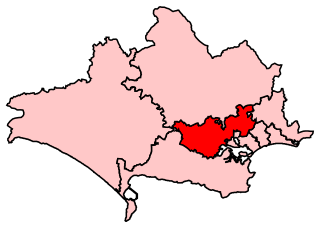
The River Frome is a river in Dorset in the south of England. At 30 miles (48 km) long it is the major chalkstream in southwest England. It is navigable upstream from Poole Harbour as far as the town of Wareham.

Purbeck was a local government district in Dorset, England. The district was named after the Isle of Purbeck, a peninsula that forms a large proportion of the district's area. However it extended significantly further north and west than the traditional boundary of the Isle of Purbeck along the River Frome. The district council was based in the town of Wareham, which is itself north of the River Frome.

Church Knowle is a village and civil parish on the Isle of Purbeck in the county of Dorset in the south of England.

The Swanage Railway is a railway branch line from near Wareham, Dorset to Swanage, Dorset, England, opened in 1885 and now operated as a heritage railway.

Wytch Farm is an oil field and processing facility in the Purbeck district of Dorset, England. It is the largest onshore oil field in western Europe. The facility, taken over by Perenco in 2011, was previously operated by BP. It is located in a coniferous forest on Wytch Heath on the southern shore of Poole Harbour, two miles (3.2 km) north of Corfe Castle. Oil and natural gas (methane) are both exported by pipeline; liquefied petroleum gas is exported by road tanker.

Mid Dorset and North Poole is a constituency represented in the House of Commons of the UK Parliament since 2015 by Michael Tomlinson, a Conservative.

Swanage railway station is a railway station located in Swanage, on the Isle of Purbeck in the English county of Dorset. Originally the terminus of a London and South Western Railway (L&SWR) branch line from Wareham, the line and station were closed by British Rail in 1972. It has since reopened as a station on the Swanage Railway, a heritage railway that currently runs from Norden station just north of Corfe Castle to Swanage station. It now also runs to Wareham on certain services, but not on regular services due to signalling problems.

Corfe Castle railway station is a railway station located in the village of Corfe Castle, in the English county of Dorset.

Norden railway station is a railway station located one mile to the north of the village of Corfe Castle, on the Isle of Purbeck in the English county of Dorset. It is situated on the Swanage Railway, a heritage railway that operates over the former London and South Western Railway line from Wareham to Swanage. Norden is the northern terminus of the railway's steam service from Swanage, and an intermediate stop on the railway's diesel hauled service that connects Swanage with the national rail network at Wareham station.

Ridge is a village in the English county of Dorset. It is situated on the south bank of the River Frome, about half a mile due south east of the town of Wareham.

Blue Pool is a flooded, disused clay pit where Purbeck ball clay was once extracted. It is now a lake within the Furzebrook Estate, a 25-acre (10 ha) park of heath woodland and gorse near Furzebrook on the Isle of Purbeck, in the county of Dorset, southern England.

Furzebrook is a small village on the Isle of Purbeck, in the county of Dorset in the south of England. It is about 2 miles (3.2 km) south of Wareham and 2 miles (3.2 km) northwest of Corfe Castle, and is in the civil parish of Church Knowle.

Dorset is a county located in the middle of the south coast of England. It lies between the latitudes 50.512°N and 51.081°N and the longitudes 1.682°W and 2.958°W, and occupies an area of 2,653 km². It spans 90 kilometres (56 mi) from east to west and 63 kilometres (39 mi) from north to south.

Hartland Moor is a Site of Special Scientific Interest (SSSI) on the south side of Poole Harbour near the town of Wareham in Dorset, England. It consists of lowland heathland.

The Purbeck Mineral and Mining Museum exists to preserve and interpret the historic extractive industries in ball clay mining in the Isle of Purbeck. The museum is located adjacent to Norden station on the Swanage Railway and is open from the end of March to the end of September on weekends, some weekdays and Bank Holidays.
























